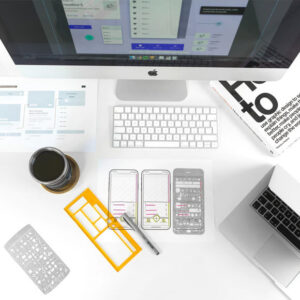It has been named as one of the most popular top user interface (UI) trends in web design in recent years, but a new study has suggested that ‘flat’ design could be costing brands billions in lost revenue.
What is flat UI design?
One of the best ways to picture flat UI design is on Microsoft’s Windows 8, which uses simple, icon-like images to create a minimalist and supposedly more user-friendly interface. Flat interfaces aren’t lifelike and ornamental elements are considered to be clutter. Microsoft and other champions of flat UI design claimed it improved usability and functionality as it used bright, contrasting colours to make buttons and illustrations ‘pop’ out from the background. It was also believed to convey messages more effectively through the use of simple icons and images.
Flat designs offer ‘weak clickability signifiers’
Important new research by the Nielsen Norman Group has found that flat user interfaces don’t offer the aesthetic appeal and increased usability to web users that many would imagine. In fact, quite the opposite appears to be the case. Researchers found that flat design removes many of the visual clues that users need to understand what is clickable. Ultimately, this makes websites slower to navigate and could be costing brands billions in revenue.
Researchers took 9 websites and created two versions of each – one the original flat design and one which added shadows, gradients and text treatments to add depth. Study participants were then asked to find the interactive element on the page and click it, while researchers analysed how long it took. They found that on average, participants took 22% longer to find the interactive element on flat UI websites and that their gaze lingered on 25% more points on the page.
These findings suggest that flat design increases the interaction cost for site owners and slows down the user experience. The published report states:
“We want our users to have experiences that are easy, seamless, and enjoyable. Users need to be able to look at a page, and understand their options immediately. They need to be able to glance at what they’re looking for and know instantly, “Yep, that’s it.”
Designs with weak clickability signifiers waste users’ time: people need to look at more UI elements and spend more time on the page, as captured by heatmaps, average counts of fixations, and average task time. These findings all suggest that with weak signifiers, users are getting less of that feeling of empowerment and decisiveness. They’re experiencing click uncertainty.”
If you have a flat UI design on your site, don’t panic and call your web designer just yet. The study also pointed out that in certain conditions, flat designs can work. For example, when your site has low information density, places interactive elements where they stand out or has a traditional or consistent design – preferably all three of these conditions together.
If you’re concerned that your current web design isn’t working for you, get in touch with the expert team at Ambos Digital.








